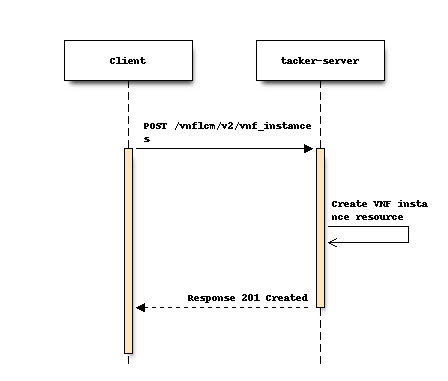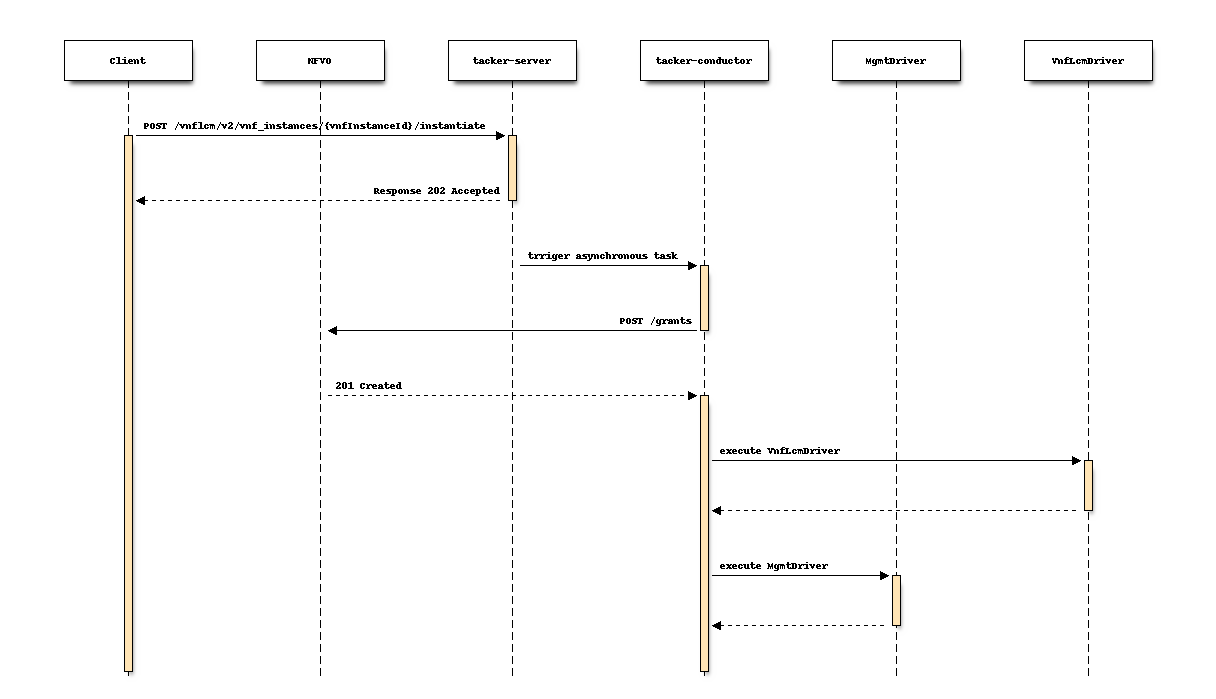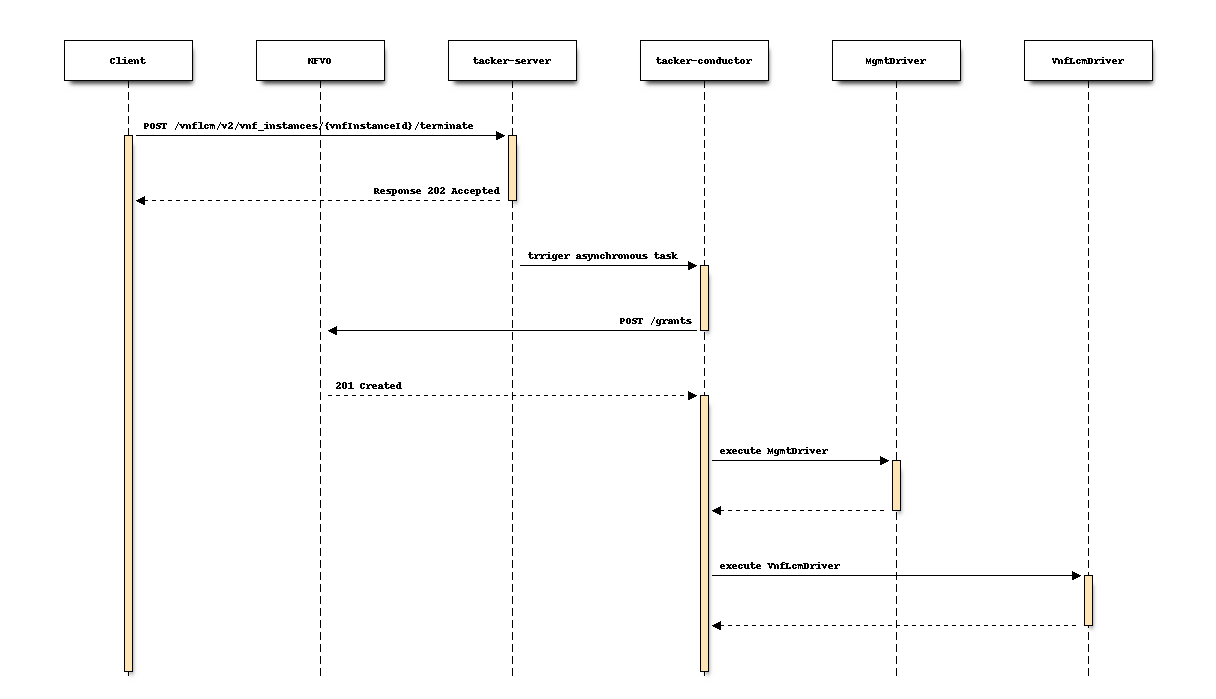Support NFV SOL_v3 starting and terminating¶
https://blueprints.launchpad.net/tacker/+spec/support-nfv-solv3-start-and-terminate-vnf
This specification supports a new version of VNF lifecycle management APIs complying with ETSI NFV SOL v3. It adds a new version of APIs involved in starting VNF and terminating VNF.
Problem description¶
ETSI specifications within the NFV Architecture Framework [1] describe the main aspects of NFV development and usage based on the industry needs, feedback from SDN/NFV vendors and telecom operators. These specifications include the REST API and data model architecture which is used by NFV users and developers in related products.
Support of key ETSI NFV specifications will significantly reduce efforts for Tacker integration into Telecom production networks and also will simplify further development and support of future standards. In Wallaby release, VNF lifecycle management operations defined in ETSI NFV SOL002 v2.6.1 [2] and SOL003 v2.6.1 [3] are supported. However, NFV continues to develop new specifications, it should comply with multiple versions of ETSI NFV SOL specification. Tacker will support VNF lifecycle management operations defined in ETSI NFV SOL002 v3.3.1 [4] and SOL003 v3.3.1 [5].
Proposed change¶
Since the VNF lifecycle management interface version specified in ETSI NFV SOL v3 is “2.0.0”, the API major version included in URI shall be set to “v2”. Supporting v2 APIs involves changing the data type of some attributes and adding or removing attributes. To avoid impact on the existing implementation, APIs corresponding to “v2” should be implemented as a process independent of that of “v1”.
The following are sample APIs supported by this interface.
Create VNF Identifier
Instantiate VNF
Terminate VNF
Delete VNF Identifier
1) Flow of creation of a VNF instance resource¶

Client sends a Create VNF request with the API major version included in URI is “v2”.
The VNFM creates a VNF instance resource and the associated VNF instance identifier.
The VNFM returns a “201 Created” response.
If necessary, VNFM performs the package acquisition process as described in the SPEC support-sol003-vnfm-operations, and the notification process as described in the SPEC support-notification-api-based-on-etsi-nfv-sol.
2) Flow of Instantiation of a VNF instance¶

Client sends an Instantiate VNF request with the API major version included in URI is “v2”.
The VNFM returns a “202 Accepted” response.
VNFM and NFVO exchange granting information.
The VNFM calls MgmtDriver and VnfLcmDriver.
If necessary, VNFM performs the notification process as described in the SPEC support-notification-api-based-on-etsi-nfv-sol.
3) Flow of Termination of a VNF instance¶

Client sends a Terminate VNF request with the API major version included in URI is “v2”.
The VNFM returns a “202 Accepted” response.
VNFM and NFVO exchange granting information.
The VNFM calls MgmtDriver and VnfLcmDriver.
If necessary, VNFM performs the notification process as described in the SPEC support-notification-api-based-on-etsi-nfv-sol.
4) Flow of deletion of a VNF instance resource¶

Client sends a Delete VNF request with the API major version included in URI is “v2”.
The VNFM deletes the “VNF instance resource” and the associated VNF instance identifier.
The VNFM returns a “204 No Content” response with an empty payload body.
If necessary, VNFM performs the notification process as described in the SPEC support-notification-api-based-on-etsi-nfv-sol.
Data model impact¶
In this SPEC with ETSI NFV SOL002 v3.3.1 [4] and SOL003 v3.3.1 [5], all defined attributes should be supported in API validation. Also, all data models in the response should be implemented in the Database to enable flexible change of logic in VNF lifecycle management.
From the above point of view, there are two motivations to change Database tables.
The first one is from supporting new attributes in v2 API. According to the SOL v3, new attributes were added from v2 API. However, the data model does not need to be changed because all new attributes are described in the current JSON data type.
The second one is from supporting all attributes defined in SOL documents. In v1 API, limited attributes are supported in API validation and stored in the Database. Database tables need to be changed to store additional supported attributes.
Below shows the Database tables for v2 API. As reference information, the difference with v1 API is also shown.
Note
Since Tacker manages a separate database for each major version, the design or the change of them does not affect each other.
VnfInstance
v1 API (vnf_instances)
v2 API (VnfInstanceV2)
Changes from v1 API
Data type
id
id
Data type changed
varchar(36) NOT NULL -> varchar(255) NOT NULL
vnf_instance_name
vnfInstanceName
Renamed
<no_changed>
vnf_instance_description
vnfInstanceDescription
Renamed and Data type changed
varchar(1024) DEFAULT NULL -> text DEFAULT NULL
vnfd_id
vnfdId
Renamed and Data type changed
varchar(36) NOT NULL -> varchar(255) NOT NULL
vnf_provider
vnfProvider
Renamed
<no_changed>
vnf_product_name
vnfProductName
Renamed
<no_changed>
vnf_software_version
vnfSoftwareVersion
Renamed
<no_changed>
vnfd_version
vnfdVersion
Renamed
<no_changed>
vnfConfigurableProperties
Added
json DEFAULT NULL
vim_connection_info
vimConnectionInfo
Renamed
<no_changed>
instantiation_state
instantiationState
Data type changed
varchar(255) NOT NULL -> enum(‘NOT_INSTANTIATED’,’INSTANTIATED’) NOT NULL
instantiatedVnfInfo
AddedinstantiatedVnfInfo field corresponding to vnf_instantiated_info in v1 API is merged in VnfInstanceV2 table and json data is stored directly.json DEFAULT NULL
vnf_metadata
metadata
Renamed
<no_changed>
extensions
Added
json DEFAULT NULL
task_state
Deleted
tenant_id
Deleted
vnf_pkg_id
Deleted
created_at
Deleted
updated_at
Deleted
deleted_at
Deleted
deleted
Deleted
VnfLcmOpOcc
v1 API (vnf_lcm_op_occs)
v2 API (VnfLcmOpOccV2)
Changes from v1 API
Data type
id
id
Data type changed
varchar(36) NOT NULL -> varchar(255) NOT NULL
operation_state
operationState
Renamed and Data type changed
varchar(16) DEFAULT NULL -> enum(‘STARTING’,’PROCESSING’,’COMPLETED’,’FAILED_TEMP’,’FAILED’,’ROLLING_BACK’,’ROLLED_BACK’) NOT NULL
state_entered_time
stateEnteredTime
Renamed
<no_changed>
start_time
startTime
Renamed
<no_changed>
vnf_instance_id
vnfInstanceId
Renamed and Data type changed
varchar(36) NOT NULL -> varchar(255) NOT NULL
grant_id
grantId
Data type changed
varchar(36) NOT NULL -> varchar(255) NOT NULL
operation
operation
Data type changed
varchar(16) DEFAULT NULL -> enum(‘INSTANTIATE’,’SCALE’,’SCALE_TO_LEVEL’,’CHANGE_FLAVOUR’,’TERMINATE’,’HEAL’,’OPERATE’,’CHANGE_EXT_CONN’,’MODIFY_INFO’,’CREATE_SNAPSHOT’,’REVERT_TO_SNAPSHOT’,’CHANGE_VNFPKG’) NOT NULL
is_automatic_invocation
isAutomaticInvocation
Renamed
<no_changed>
operation_params
operationParams
Renamed
<no_changed>
is_cancel_pending
isCancelPending
Renamed
<no_changed>
cancelMode
Added
enum(‘GRACEFUL’,’FORCEFUL’) DEFAULT NULL
error
error
<no_changed>
<no_changed>
resource_changes
resourceChanges
Renamed
<no_changed>
changed_info
changedInfo
Renamed
<no_changed>
changed_ext_connectivity
changedExtConnectivity
Renamed
<no_changed>
modificationsTriggeredByVnfPkgChange
AddedNew field defined SOL003 v3.3.1 [5] “F.2.1 FEAT02: VNF Software modification”.json DEFAULT NULL
vnfSnapshotInfoId
AddedNew field defined SOL003 v3.3.1 [5] “F.2.4 FEAT15: VNF snapshotting”.varchar(255) DEFAULT NULL
error_point
Deleted
created_at
Deleted
updated_at
Deleted
deleted_at
Deleted
deleted
Deleted
REST API impact¶
All defined attributes should be supported in API validation. The “_link” attribute is the only exception because not all operations in VNF lifecycle management interface are implemented. Some links to not implemented operations should be filtered.
- Name: Create VNF IdentifierDescription: Creates a new VNF instance resourceMethod type: POSTURL for the resource: /vnflcm/v2/vnf_instancesRequest:
Data type
Cardinality
Description
CreateVnfRequest
1
The VNF creation parameters.
Attribute name
Data type
Cardinality
Supported in API v2 (Xena)
Supported in API v1 (Wallaby)
vnfdId
Identifier
1
Yes
Yes
vnfInstanceName
String
0..1
Yes
Yes
vnfInstanceDescription
String
0..1
Yes
Yes
metadata
KeyValuePairs
0..1
Yes
Yes
Response:Data type
Cardinality
Response Codes
Description
VnfInstance
1
Success: 201
A VNF Instance identifier was created successfully.
ProblemDetails
1
Error: 422
The content type of the payload body is supported and the payload body of a request contains syntactically correct data but the data cannot be processed.
ProblemDetails
See clause 6.4 of [6]
Error: 4xx, 5xx
Any common error response code as defined in clause 6.4 of ETSI GS NFV-SOL 013 [6] may be returned.
Attribute name
Data type
Cardinality
Supported in API v2 (Xena)
Supported in API v1 (Wallaby)
Description
id
Identifier
1
Yes
Yes
vnfInstanceName
String
0..1
Yes
Yes
vnfInstanceDescription
String
0..1
Yes
Yes
vnfdId
Identifier
1
Yes
Yes
vnfProvider
String
1
Yes
Yes
vnfProductName
String
1
Yes
Yes
vnfSoftwareVersion
Version
1
Yes
Yes
vnfdVersion
Version
1
Yes
Yes
vnfConfigurableProperties
KeyValuePairs
0..1
Yes
No
vimConnectionInfo
map(VimConnectionInfo)
0..N
Yes
Yes
In API v2, the Data type is changed from VimConnectionInfo to map(VimConnectionInfo).
instantiationState
Enum
1
Yes
Yes
metadata
KeyValuePairs
0..1
Yes
No
extensions
KeyValuePairs
0..1
Yes
No
_links
Structure (inlined)
1
Yes
Yes
>self
Link
1
Yes
Yes
>indicators
Link
0..1
No
No
>instantiate
Link
0..1
Yes
Yes
>terminate
Link
0..1
Yes
Yes
>scale
Link
0..1
Yes
Yes
>scaleToLevel
Link
0..1
No
No
>changeFlavour
Link
0..1
No
No
>heal
Link
0..1
Yes
Yes
>operate
Link
0..1
No
No
>changeExtConn
Link
0..1
Yes
Yes
>createSnapshot
Link
0..1
No
New attribute in API v2.
>revertToSnapshot
Link
0..1
No
New attribute in API v2.
- Name: Instantiate VNF taskDescription: This task resource represents the “Instantiate VNF” operation. The client can use this resource to instantiate a VNF instance.Method type: POSTURL for the resource: /vnflcm/v2/vnf_instances/{vnfInstanceId}/instantiateResource URI variables for this resource:
Name
Definition
vnfInstanceId
The identifier of the VNF instance to be instantiated.
Request:Data type
Cardinality
Description
InstantiateVnfRequest
1
Parameters passed to instantiate task.
Attribute name
Data type
Cardinality
Supported in API v2 (Xena)
Supported in API v1 (Wallaby)
Description
flavourId
IdentifierInVnfd
1
Yes
Yes
instantiationLevelId
IdentifierInVnfd
0..1
Yes
Yes
extVirtualLinks
ExtVirtualLinkData
0..N
Yes
Yes
extManagedVirtualLinks
ExtManagedVirtualLinkData
0..N
Yes
Yes
vimConnectionInfo
map(VimConnectionInfo)
0..N
Yes
Yes
In API v2, the Data type is changed from VimConnectionInfo to map(VimConnectionInfo).
localizationLanguage
String
0..1
Yes
No
additionalParams
KeyValuePairs
0..1
Yes
Yes
extensions
KeyValuePairs
0..1
Yes
No
vnfConfigurableProperties
KeyValuePairs
0..1
Yes
No
Response:Data type
Cardinality
Response Codes
Description
n/a
Success: 202
The request was accepted for processing, but the processing has not been completed.
ProblemDetails
1
Error: 409
The operation cannot be executed currently, due to a conflict with the state of the resource.
ProblemDetails
See clause 6.4 of [6]
Error: 4xx, 5xx
Any common error response code as defined in clause 6.4 of ETSI GS NFV-SOL 013 [6] may be returned.
- Name: Terminate VNF taskDescription: This task resource represents the “Terminate VNF” operation. The client can use this resource to terminate a VNF instance.Method type: POSTURL for the resource: /vnflcm/v2/vnf_instances/{vnfInstanceId}/terminateResource URI variables for this resource:
Name
Description
vnfInstanceId
The identifier of the VNF instance to be terminated.
Request:Data type
Cardinality
Description
TerminateVnfRequest
1
Parameters passed to Terminate VNF task.
Attribute name
Data type
Cardinality
Supported in API v2 (Xena)
Supported in API v1 (Wallaby)
terminationType
Enum (inlined)
1
Yes
Yes
gracefulTerminationTimeout
Integer
0..1
Yes
Yes
additionalParams
KeyValuePairs
0..1
Yes
Yes
Response:Data type
Cardinality
Response Codes
Description
n/a
Success: 202
The request was accepted for processing, but the processing has not been completed.
ProblemDetails
See clause 6.4 of [6]
Error: 4xx, 5xx
Any common error response code as defined in clause 6.4 of ETSI GS NFV-SOL 013 [6] may be returned.
- Name: Delete VNF InstanceDescription: Request to delete VNF instance resource by its idMethod type: DELETEURL for the resource: /vnflcm/v2/vnf_instances/{vnfInstanceId}Resource URI variables for this resource:
Name
Description
vnfInstanceId
Identifier of the VNF instance.
Response:Data type
Cardinality
Response Codes
Description
n/a
Success: 204
The VNF instance resource and the associated VNF identifier were deleted successfully.
ProblemDetails
1
Error: 409
The operation cannot be executed currently, due to a conflict with the state of the resource.
ProblemDetails
See clause 6.4 of [6]
Error: 4xx, 5xx
Any common error response code as defined in clause 6.4 of ETSI GS NFV-SOL 013 [6] may be returned.
Security impact¶
None
Notifications impact¶
None
Other end user impact¶
CLI options may be changed to switch between v1 API and v2 API.
Performance Impact¶
None
Other deployer impact¶
None
Developer impact¶
python-tackerclient needs to support a new attribute to set API version.
Implementation¶
Assignee(s)¶
Hirofumi Noguchi <hirofumi.noguchi.rs@hco.ntt.co.jp>
Work Items¶
Add new version API endpoints to Tacker-server.
Add new unit and functional tests.
Update the Tacker’s API documentation.
Dependencies¶
None
Testing¶
Unit and functional test cases will be added for VNF lifecycle management of VNF instances.
Documentation Impact¶
Complete user guide will be added to explain how to invoke VNF lifecycle management of VNF instances with examples.
References¶
https://www.etsi.org/deliver/etsi_gs/NFV-SOL/001_099/013/03.04.01_60/gs_nfv-sol013v030401p.pdf
